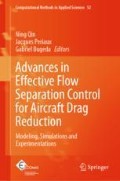Abstract
Since 1947, when Schubauer and Skramstad (J Res: 69–78, 1947 [1]) established the basis of the technology with its revolutionary work about steady state tools and mechanisms for the flow management, the progress of the flow control technology and the development of devices have progressed constantly. Anyway, the applicability of such devices is limited, and only few of them have arrived to the assembly workshop. The problem is that the range of actuation is still limited. Despite their operability limitations, flow control devices are of great interest for the aeronautical industry. The number of projects investigating this technology demonstrates the relevance of in the Fluid Dynamic field. The scientific interest focus not only on the industrial applications and the improvement of the technology, but also on the deep understanding of the physical phenomena associated to the flow separation, turbulence formation associated to the final drag reduction aim. A clear example of what has been mentioned is the EC MARS research project (MARS project, FP7 project number 266326, [2]). Its objectives are aimed to a better understanding of the Reynolds Stress and turbulent flow related to both drag reduction and flow control. The research was carried out through the analysis of several flow control devices and the optimization of the parameters for some of them was an important element of the research. When solving a traditional fluid dynamics optimisation problem numerical flow analysis are used instead of experimental ones due to their lower cost and shorter needed time for evaluation of candidate solutions. Nevertheless, in the particular case of the selected flow control plasma devices the experimental measurement of the performance of each candidate configuration has been much quicker than a numerical analysis. For this reason, the corresponding optimisation problem has been solved by coupling an evolutionary optimization algorithm with an experimental device. This paper discusses the design quality and efficiency gained by this innovative coupling.
Access this chapter
Tax calculation will be finalised at checkout
Purchases are for personal use only
References
Schubauer GB, Skramstad HK (1947) Laminar boundary-layer oscillations and transition on flat plate. United States Bureau of Standards. J Res, 69–78
MARS project, FP7 project number 266326. www.cimne.com/mars
Benard N, Moreau E (2012) EHD force and electric wind produced by plasma actuators used for airflow control. AIAA paper 3136
Eaton JK, Johnston JP (1981) A review of research on subsonic turbulent flow reattachment. AIAA J 19
Lee DS, Gonzalez LF, Periaux J, Bugeda G (2011) Double shock control bump design optimisation using hybridised evolutionary algorithms. Special Issue J Aerosp Eng 225(10):1175–1192. https://doi.org/10.1177/0954410011406210
Lee DS, Morillo C, Bugeda G, Oller S, Onate E (2011) Multilayered composite structure design optimisation using distributed/parallel multi-objective evolutionary algorithms. J Compos Struct. https://doi.org/10.1016/j.compstruct.2011.10.009
Lee DS, Periaux J, Onate E, Gonzalez LF (2011) Advanced computational intelligence system for inverse aeronautical design optimisation. In: International Conference on advanced software engineering (ICASE-11), Proceedings of the 9th IEEE international symposium on parallel and distributed processing with applications workshops, ISPAW 2011—ICASE 2011, SGH 2011, GSDP 2011, Busan, Korea, 26–28 May, 2011, pp 299–304. ISBN 978-1-4577-0524-3. https://doi.org/10.1109/ispaw.2011.46
Lee DS, Periaux J, Gonzalez LF. UAS mission path planning system (MPPS) using hybrid-game coupled to multi-objective optimiser. J Dyn Syst Meas Control. DS-09-1135
Deb K, Agrawal S, Pratap A, Meyarivan T (2002) A fast and elitist multi-objective genetic algorithm: NSGA-II. IEEE Trans Evol Comput 6(2):182–197
Lee DS, Gonzalez LF, Periaux J, Srinivas K. Hybrid-game strategies coupled to evolutionary algorithms for robust multidisciplinary design optimization in aerospace engineering. IEEE Trans Evol Comput. TEVC-00213-2009
Periaux J, Lee DS, Gonzalez LF, Srinivas K (2009) Fast reconstruction of aerodynamic shapes using evolutionary algorithms and virtual nash strategies in a CFD design environment. Special Issue J Comput Appl Math 232(1):61–71. ISSN 0377-0427
Acknowledgements
This research has been partially funded by the European Commission (EC), though the Framework Programme 7 (FP7) and the Ministry of Industry and Information Technology of the People Republic of China (MIIT), Project # 266326 entitled: “Manipulation of Reynolds Stress for Separation Control and Drag Reduction” (MARS).
Author information
Authors and Affiliations
Corresponding author
Editor information
Editors and Affiliations
Rights and permissions
Copyright information
© 2020 Springer Nature Switzerland AG
About this chapter
Cite this chapter
Benard, N., Pons-Prats, J., Périaux, J., Bonnet, JP., Bugeda, G. (2020). Optimization of the Experimental Set-up for a Turbulent Separated Shear Flow Control by Plasma Actuator Using Genetic Algorithms. In: Qin, N., Periaux, J., Bugeda, G. (eds) Advances in Effective Flow Separation Control for Aircraft Drag Reduction. Computational Methods in Applied Sciences, vol 52. Springer, Cham. https://doi.org/10.1007/978-3-030-29688-9_9
Download citation
DOI: https://doi.org/10.1007/978-3-030-29688-9_9
Published:
Publisher Name: Springer, Cham
Print ISBN: 978-3-030-29687-2
Online ISBN: 978-3-030-29688-9
eBook Packages: EngineeringEngineering (R0)

